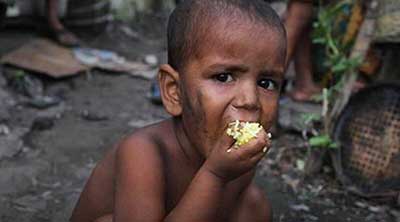Relevance: GS-2: Welfare schemes for vulnerable sections of society, issues related to the development of the social sector, issues related to poverty and hunger, etc
Key Phrases: Direct Nutrition Interventions, Child Malnutrition, for Prime Minister’s Overarching Scheme for Holistic Nourishment (POSHAN), POSHAN 2.0, Integrated Child Development Services (ICDS), Exclusive Breastfeeding (EBF)
Context:
- As India launches the celebrations of its 75th anniversary of Independence, there is much to be proud of; but still, it is disconcerting that even after seven decades of Independence, India is afflicted by public health issues such as child malnutrition (35.5% stunted, 67.1% anaemic) attributing to 68.2% of under-five child mortality.
POSHAN Abhiyan
- POSHAN stands for Prime Minister’s Overarching Scheme for Holistic Nourishment.
- It was launched by the Ministry of Women and Child Development (MWCD).
- It is also called National Nutrition Mission.
- The government of India launched the POSHAN Abhiyan in 2018 to ensure a Malnutrition Free India by 2022.
- It aims to reduce stunting in children from 38.4 percent to 25 percent by 2022.
POSHAN 2.0
- POSHAN 2.0 is an umbrella scheme covering the Integrated Child Development Services (ICDS) (Anganwadi Services, Poshan Abhiyan, Scheme for Adolescent Girls, National Creche Scheme).
- It was announced in Union Budget 2021-22 by merging supplementary nutrition programs and the POSHAN Abhiyaan.
- Poshan 2.0 will seek to optimize the quality and delivery of food under the Supplementary Nutrition Program.
- The focus is on the 1,000 days (270 days of pregnancy and 730 days; 0-24 months) between a mother’s pregnancy and her child’s second birthday, prioritizing women and girls, and addressing their nutritional deficiencies through fortification and provision of take-home rations.
Improvements in some indicators:
- Data from the National Family Health Survey (NFHS)-5 2019-21, as compared to NFHS-4 2015-16, reveals a substantial improvement in a period of four to five years in several proxy indicators of women’s empowerment.
- There is a substantial improvement in
- antenatal service attendance (58.6 to 70.0%);
- women having their own savings bank accounts (63.0 to78.6%);
- women owning mobile phones that they use (45.9 % to 54.0%);
- women married before 18 years of age (26.8 % to 23.3 %);
- women with 10 or more years of schooling (35.7% to 41.0%), and
- access to clean fuel for cooking (43.8 % to 68.6%).
Areas that still need a focus:
- The country has not progressed well in terms of direct nutrition interventions.
- Preconception nutrition, maternal nutrition, and appropriate infant and child feeding remain to be effectively addressed.
- India has 20% to 30% undernutrition even in the first six months of life when exclusive breastfeeding is the only nourishment required.
- Neither maternal nutrition care interventions nor infant and young child feeding practices have shown the desired improvement.
- Despite a policy on infant and young child feeding, and a ban on the sale of commercial milk for infant feeding, there has only been a marginal improvement in the practice of exclusive breastfeeding (EBF).
The problem of low awareness:
- NFHS-5 also confirms a gap in another nutrition intervention — complementary feeding practices, i.e., complementing semi-solid feeding with the continuation of breast milk from six months onwards.
- Poor complementary feeding is often due to a lack of awareness to start feeding at six to eight months, what and how to feed appropriately family food items, how frequently, and in what quantity.
- The fact that 20% of children in higher socio-economic groups are also stunted indicates poor knowledge in food selection and feeding practices and a child’s ability to swallow mashed food.
Suggestions:
- Creating Awareness:
- Child undernutrition in the first three months remains high. Creating awareness of exclusive breastfeeding (EBF), and promoting the technique of appropriate holding, latching, and manually emptying the breast are crucial for the optimal transfer of breast milk to a baby.
- Creating awareness at the right time with the right tools and techniques regarding special care in the first 1,000 days deserves very high priority.
- India can give a major boost to POSHAN 2.0, as it did to Swachh Bharat Abhiyaan, using an awareness program.
- Revisit system for nutrition program:
- There is a pressing need to revisit the system spearheading POSHAN 2.0 and overhaul it to remove any flaws in its implementation.
- There is a need to revisit the nodal system for nutrition program existing since 1975, the Integrated Child Development Scheme (ICDS) under the Ministry of Women and Child, and examine whether it is the right system for reaching mother-child in the first 1000 days of life.
- Alternative way to distribute ICDS supplies:
- There is also a need to explore whether there is an alternative way to distribute the ICDS supplied supplementary nutrition as Take-Home Ration packets through the Public Distribution (PDS) and free the Anganwadi workers of the ICDS to undertake timely counselling on appropriate maternal and child feeding practices.
- Test a new system:
- There is a need to systematically review the status, and develop and test a new system that would combine the human resource of ICDS and health from the village to the district and state levels.
- This would address the mismatch that exists in focussing on the delivery of services in the first 1000 days of life for preventing child undernutrition by having an effective accounting system.
Conclusion:
- It is time to think out of the box and overcome systemic flaws and our dependence on the antiquated system of the 1970s that is slowing down the processes.
- Moreover, mass media or TV shows could organize discourses on care in the first 1,000 days to reach mothers outside the public health system.
Source: The Hindu
Mains Question:
Q. Preconception nutrition, maternal nutrition and child feeding practices in the first 1,000 days of life are the keys to preventing child malnutrition. Discuss.







